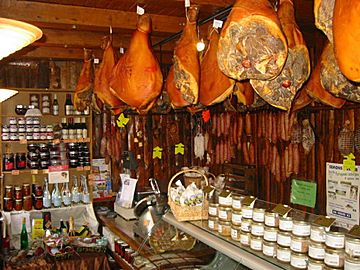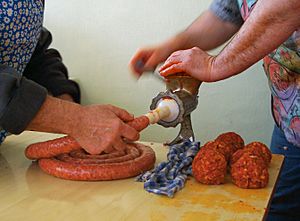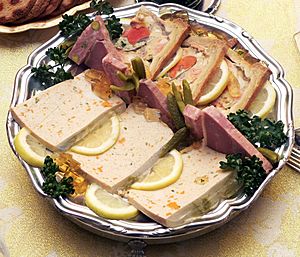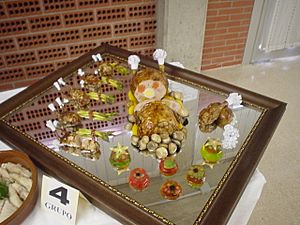Charcuterie facts for kids
Charcuterie (say "shar-KOO-tər-ee") is a French word for a special kind of cooking. It's all about making prepared meat products. Think of things like bacon, ham, sausage, and different kinds of meat pies called pâtés or terrines. Most of these foods are made from pork.
Charcuterie was first created as a way to keep meat fresh before people had refrigerators. Today, these foods are loved for their amazing flavors, which come from the special ways they are preserved.
Contents
What Does Charcuterie Mean?
The French word for someone who makes charcuterie is charcutier. The word charcuterie comes from two old French words: chair, meaning "flesh" or "meat", and cuite, meaning "cooked". So, it literally means "cooked meat".
A charcuterie can also be the name of a shop where these delicious meat products are made and sold. It's like a special deli!
Meats Made with Forcemeats
What is Forcemeat?
Forcemeat is a mix of ground, lean meat and fat. It's blended together to make a smooth or slightly chunky paste. This blending can be done by grinding the ingredients very finely or by puréeing them. The texture depends on what the final food will be like.
Forcemeats are used to make many different charcuterie items. Common meats used include pork, fish (like pike or salmon), seafood, game meats (like venison or rabbit), poultry (like chicken), and veal. Pork fatback is often used for the fat part because it has a mild flavor.
There are a few main types of forcemeat:
- Straight forcemeats are made by grinding equal parts of pork and pork fat, often with another meat.
- Country-style forcemeats mix pork, pork fat, and sometimes pork liver, along with other ingredients. They have a rougher texture.
- Gratin forcemeats have some of the main meat browned first.
- Mousseline forcemeats are very light and airy. They use lean meats like veal, poultry, or fish, and have eggs and cream added.
Sausage Making
The word sausage comes from a Latin word meaning "salt". This is because sausages are made by putting ground or chopped meat with salt into a tube-like casing. These casings can be made from animal parts, like the linings of sheep, hog, or cattle intestines. Sometimes, animal stomachs or bladders are used. There are also artificial casings made from collagen or plant materials.
Casings help shape, store, and age the sausage. There are two main types of sausage:
- Fresh sausages are raw meat placed into casings. You cook them later.
- Cooked sausages are heated during production. They are ready to eat when you buy them.
Smooth Sausages
Smooth sausages are a type of cooked sausage with a very fine texture. They are made by blending pork, beef, or poultry with fat, salt, and flavorings. These ingredients are mixed at high speed in a food processor. This process helps the fat mix perfectly with the meat.
It's important to keep the temperature low during this process. If the mixture gets too warm, the fat might separate from the meat when it cooks.
Pâté, Terrine, Galantine, Roulade
Pâté and terrines are often cooked in a pastry crust or a special earthenware dish. The dish itself is also called a terrine. Pâté and terrine are quite similar. Pâté often has a finer texture and uses liver, while terrines usually have a coarser texture.
The meat is chopped or ground and mixed with lots of seasonings, fat, and herbs. Seasoning is very important because these dishes are usually served cold, which can make flavors seem less strong.
The mixture is put into a lined mold, covered, and cooked in a water bath. This helps control the temperature and stops the meat from separating. After cooking, the terrine is cooled and often pressed down with a weight. It then rests for a few days so the flavors can blend together perfectly.
A Galantine is a chilled poultry dish. It was first made in France after the French Revolution. The word galant means sophisticated.
To make a galantine, a chicken or other poultry is carefully skinned and boned. The skin is laid flat, and the pounded breast meat is placed on top. Then, a forcemeat mixture is spread over the breast. The whole thing is rolled up, wrapped in cheesecloth, and gently cooked in poultry stock until it's done.
A Roulade is similar to a galantine. The main differences are how it's rolled (into a pinwheel shape) and how it's cooled (chilled after cooking).
Salt-Cured Meats
Salt is super important for keeping food fresh in charcuterie. It works in a few ways:
- Osmosis: Salt helps pull water out of the meat cells. This helps get rid of harmful germs.
- Dehydration: Salt removes extra water from the meat. Less water means bacteria can't grow as easily, so the meat lasts longer.
- Fermentation: Salt helps control the fermentation process, which adds flavor but stops the meat from breaking down too much.
- Denaturing proteins: Salt changes the structure of the meat's proteins, similar to how cooking changes them.
Before the early 1900s, people used plain salt and saltpeter (potassium nitrate) to cure meats. Now, sodium nitrite and sodium nitrate are often used because they work more consistently to prevent bacteria. Nitrates break down slowly, so they are good for meats that need a long curing time. Nitrites work faster and are used for meats that will be cooked soon.
Nitrites do several things in curing:
- They give the meat a sharp, tangy flavor.
- They stop fat from going bad.
- They create the reddish color you see in most cured meats.
- They stop the growth of dangerous bacteria that can cause food poisoning.
Some studies have linked eating cured meats to a very small increase in certain health risks. However, these risks are generally considered very small. In places like the United States, there are strict rules about how much nitrite can be used in cured meats to keep them safe.
Curing Salt Mixes
Two main types of curing salt mixes are used:
- Pink cure (also called "Prague powder #1" or "insta-cure #1") is 93.75% regular salt and 6.25% sodium nitrite. It's colored bright pink so people don't confuse it with regular salt. You only need a tiny bit of this mix for a lot of meat.
- Prague powder #2 (or "insta-cure #2") is also pink. It has 6.25% sodium nitrite, 4% sodium nitrate, and 89.75% regular salt. This mix is used for dry sausages that need to dry for a long time, which requires the nitrate.
Seasoning and Flavors
Sweeteners and other flavors are important in cured meats because salt can have a strong taste. Sweeteners like dextrose, sugar, honey, and maple syrup can be used. Dextrose is common because it makes the salt taste less harsh and keeps the meat moist, without adding too much sweetness. Sweeteners also help keep the meat's color nice and help good bacteria grow during fermentation.
Many spices and herbs are also used to add flavor. Sweet spices like cinnamon, allspice, nutmeg, and cardamom are popular. Other flavors can come from chilies, wine, fruit juice, or vinegar.
Fermented Sausage
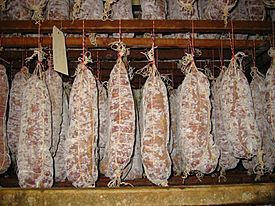
Fermented sausages are made by salting chopped or ground meat to remove moisture. This process also allows helpful bacteria to break down sugars into tasty flavors. Bacteria, like Lactobacillus, create lactic acid. This acid not only adds flavor but also lowers the pH of the sausage. A lower pH stops bad bacteria from growing, which helps keep the sausage safe and fresh. These effects become even stronger as the sausage dries, because the salt and acidity become more concentrated.
See also
 In Spanish: Charcutería para niños
In Spanish: Charcutería para niños


